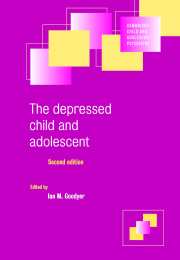Book contents
- Frontmatter
- Contents
- List of contributors
- Preface
- 1 Historical aspects of mood and its disorders in young people
- 2 The development of emotional intelligence
- 3 Developmental precursors of depression: the child and the social environment
- 4 Physiological processes and the development of childhood and adolescent depression
- 5 Childhood depression: clinical phenomenology and classification
- 6 The epidemiology of depression in children and adolescents
- 7 Family–genetic aspects of juvenile affective disorders
- 8 Life events: their nature and effects
- 9 Adolescent depression: neuroendocrine aspects
- 10 Suicidal behaviour in adolescents
- 11 Psychopharmacology of depressive states in childhood and adolescence
- 12 The psychotherapeutic management of major depressive and dysthymic disorders in childhood and adolescence: issues and prospects
- 13 Natural history of mood disorders in children and adolescents
- Index
1 - Historical aspects of mood and its disorders in young people
Published online by Cambridge University Press: 18 December 2009
- Frontmatter
- Contents
- List of contributors
- Preface
- 1 Historical aspects of mood and its disorders in young people
- 2 The development of emotional intelligence
- 3 Developmental precursors of depression: the child and the social environment
- 4 Physiological processes and the development of childhood and adolescent depression
- 5 Childhood depression: clinical phenomenology and classification
- 6 The epidemiology of depression in children and adolescents
- 7 Family–genetic aspects of juvenile affective disorders
- 8 Life events: their nature and effects
- 9 Adolescent depression: neuroendocrine aspects
- 10 Suicidal behaviour in adolescents
- 11 Psychopharmacology of depressive states in childhood and adolescence
- 12 The psychotherapeutic management of major depressive and dysthymic disorders in childhood and adolescence: issues and prospects
- 13 Natural history of mood disorders in children and adolescents
- Index
Summary
Introduction
The last 20 years have witnessed rapid expansion of clinical and theoretical interest in affective disorders in children and adolescents. Extensive historical examination of the subject has however been minimal. The primary aims of this chapter, therefore, are to assemble evidence about the wider historical background and to set some current clinical and research issues in perspective. The methodology and interpretation of historical research on affective disorder in young people need to take into consideration a number of factors.
Growth of interest in juvenile mental disorder
Prior to the mid nineteenth century, little systematic attention was given to juvenile lunatics and the existence of insanity in early life was disputed or denied. A picture of their disorders and care has to be assembled, therefore, from diverse sources, mainly reports of unusual cases (Parry-Jones, 1993). Subsequently, insanity in children and adolescents featured increasingly in asylum practice and in textbooks and journals, although it was not until the 1920s and 1930s that a recognizably separate discipline of child psychiatry emerged. The multidisciplinary speciality that took shape was the product of the confluence of expertise from paediatrics, asylum medicine, the training and custodial care of the mentally retarded, psychoanalysis, psychology, psychiatric social work, remedial education and criminology. Later, influenced by the new medical psychology and by psychoanalytic thinking, the developing speciality moved away from asylum-based psychiatry, with its concepts of organ pathology, heredity, phenomenological syndromal description and physical treatments, towards psychosocial and psychodynamic models.
Keywords
- Type
- Chapter
- Information
- The Depressed Child and Adolescent , pp. 1 - 23Publisher: Cambridge University PressPrint publication year: 2001

